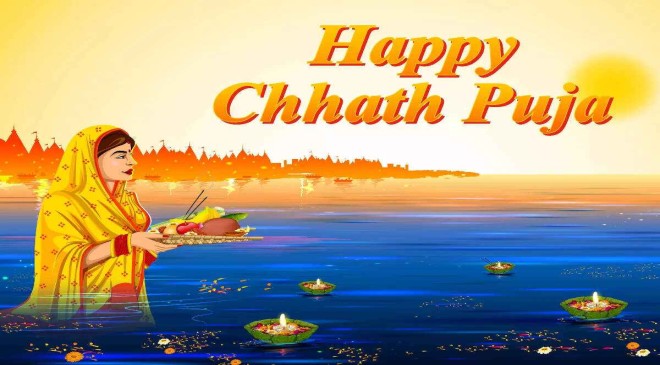Chhath Puja 2024 will be observed with the same devotion and grandeur that it has been for centuries. It stands as a testament to the deep-rooted cultural and spiritual connection between humanity and nature.
Chhath Puja is a significant and ancient Hindu festival dedicated to the worship of the Sun God, Surya, and his consort, Chhathi Maiya. This festival, mainly observed in the Indian states of Bihar, Jharkhand, Uttar Pradesh, and parts of Nepal, honors the sun as a source of life, energy, and health. Celebrated with immense devotion, Chhath Puja is unique because it focuses on gratitude, spirituality, and the purification of the mind and body.
Read More: Chhath Puja 2024: 7 Prasad Items You Must Have In Thali
Concept and Significance Behind Chhath Puja
The roots of Chhath Puja can be traced back to ancient Vedic times, with mentions in scriptures and stories that emphasize the worship of natural elements. The Sun God, considered the sustainer of life on Earth, is venerated for providing nourishment and promoting well-being. Chhathi Maiya, often regarded as an incarnation of Goddess Usha, is believed to be the deity who grants blessings of offspring and protection of children.
The festival is observed as a way of expressing gratitude for the bounties of nature and invoking divine blessings for health, prosperity, and happiness. It also symbolizes purity, simplicity, and devotion, as devotees practice rigorous rituals and abstain from luxury.
Key Rituals and Phases of Chhath Puja
Chhath Puja is celebrated over four days, each filled with its own set of rituals and significance:
1. Nahay Khay (Day 1)
The first day marks the beginning of Chhath Puja. Devotees purify themselves by bathing in sacred rivers or water bodies and cleaning their homes. They prepare a simple vegetarian meal, which usually includes rice, dal, and pumpkin-based dishes. This meal is consumed as prasad and is meant to symbolize purity and simplicity.
2. Lohanda and Kharna (Day 2)
On the second day, known as Kharna, devotees fast from sunrise until sunset without consuming water. At sunset, they prepare a meal comprising kheer (a sweet rice pudding), chapatis, and fruits. This food is offered to the gods and shared among family and neighbors. The consumption of this meal marks the end of the fast for the day, and from this point, the 36-hour nirjala (waterless) fast begins.
3. Sandhya Arghya (Day 3)
The third day is the most significant. Devotees prepare offerings, including baskets of fruits, sweets, and thekua (a traditional cookie made from wheat flour and jaggery). These offerings are taken to a riverbank or any water body where the evening ritual, known as Sandhya Arghya, is performed. Devotees stand in the water and offer arghya (water) to the setting sun, accompanied by devotional songs and hymns. This ritual signifies the acknowledgment of the sun’s vital energy as it sets.
4. Usha Arghya (Day 4)
On the final day, known as Usha Arghya, devotees gather at the riverbank before sunrise to offer arghya to the rising sun. This ritual symbolizes the rejuvenation of life and the continuation of blessings. After completing the prayers and rituals, devotees break their fast and share the prasad with family, friends, and neighbors, marking the end of Chhath Puja.
Read More: Chhath Puja 2024: Astrologer Shares Dos And Don’ts
Customs and Traditions
Sacred Offerings: The items offered during Chhath Puja hold symbolic meanings. Fruits, coconuts, and thekua represent natural abundance and the sustenance provided by the Earth.
Vrat (Fasting): The practice of fasting, especially the 36-hour waterless fast, demonstrates immense willpower and dedication. It is believed to purify the devotee both physically and spiritually.
Songs and Folk Music: Devotional Chhath songs play an essential role in the celebration, creating a spiritual ambiance and reinforcing cultural values. These songs, passed down through generations, reflect themes of devotion and respect for nature.
Community Gatherings: Chhath Puja is not just a religious event but also a communal celebration. Families and communities come together, fostering unity and shared devotion.
Spiritual and Environmental Aspects
The rituals of Chhath Puja promote environmental consciousness. Devotees prefer biodegradable items such as bamboo baskets, leaves, and earthen lamps for their offerings. By performing the rituals near water bodies, they highlight the need to protect these vital resources.
Moreover, Chhath Puja is seen as a practice that aligns body, mind, and spirit. The fast and immersion in water are believed to detoxify the body, while meditation and prayers calm the mind, bringing inner peace.
For many, Chhath Puja is more than a festival; it is a heartfelt tradition that brings together families and communities in a shared expression of gratitude, reinforcing faith in the divine forces that nurture life on Earth.
(This article is intended for your general information only. )





































